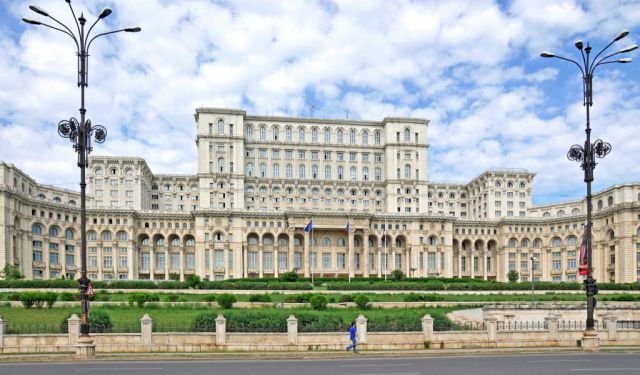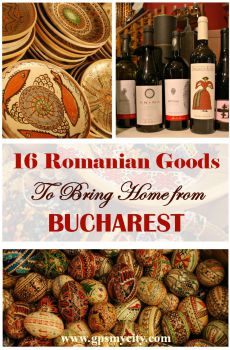
Calea Victoriei (Victory Avenue), Bucharest (must see)
Calea Victoriei (Victory Avenue) is a major avenue in central Bucharest. Situated in Sector 1, and having a length of 2.7 kilometres (1.7 mi), it leads from Splaiul Independenței (which runs parallel to the Dâmbovița River) to the north and then northwest up to Piața Victoriei, where Șoseaua Kiseleff continues north.
Initially, the road was known as Ulița Mare (Large Street), also known as Drumul Brașovului (Brașov Road), being part of the trade route between Bucharest and the city of Brașov, in Transylvania. In 1692, ruler Constantin Brâncoveanu paved the road with wood and partly regularized it, making it pass through the domains of the Bălăceni, of the Saint John Monastery, Zlătari Monastery and of the Cantacuzenes up to the Sărindari Monastery. Since 1692 it was known as Podul Mogoșoaiei (Mogoșoaia Wood-Paved Road) because it also was connecting the Bucharest's center with Brâncoveanu's Mogoșoaia Palace some kilometres outside the city.
Most roads in the Balkans at that time became muddy in the spring and autumn, and the wood prevented this. Consequently, the road was one of the most important construction works of the area and a source of pride to Bucharesters. The area surrounding the road became the most fashionable part of Bucharest: 35 boyar houses were located on the road itself in 1775.
Podul Mogoșoaiei was the first street in Bucharest to be illuminated with candles during the night, starting July 1814.
The wood was not a very sturdy material and often it was in a bad state, despite being repaired several times (including in 1793 and 1814). During the Russian occupation of the Danubian Principalities, in the aftermath of the Russo-Turkish War (1828–1829), an extension from Piața Victoriei northward was built by Pavel Kiseleff, the commander of the occupation troops, and is today named after him. In 1842 the road was paved with cobblestone. It was later upgraded to asphalt.
The road was renamed "Calea Victoriei" on October 12, 1878, following the Romanian victory in the Independence War of 1877–1878.
Today, the avenue is lined with new fashion shops, art boutiques, coffee shops and restaurants, making it an upmarket shopping strip in Bucharest.
Initially, the road was known as Ulița Mare (Large Street), also known as Drumul Brașovului (Brașov Road), being part of the trade route between Bucharest and the city of Brașov, in Transylvania. In 1692, ruler Constantin Brâncoveanu paved the road with wood and partly regularized it, making it pass through the domains of the Bălăceni, of the Saint John Monastery, Zlătari Monastery and of the Cantacuzenes up to the Sărindari Monastery. Since 1692 it was known as Podul Mogoșoaiei (Mogoșoaia Wood-Paved Road) because it also was connecting the Bucharest's center with Brâncoveanu's Mogoșoaia Palace some kilometres outside the city.
Most roads in the Balkans at that time became muddy in the spring and autumn, and the wood prevented this. Consequently, the road was one of the most important construction works of the area and a source of pride to Bucharesters. The area surrounding the road became the most fashionable part of Bucharest: 35 boyar houses were located on the road itself in 1775.
Podul Mogoșoaiei was the first street in Bucharest to be illuminated with candles during the night, starting July 1814.
The wood was not a very sturdy material and often it was in a bad state, despite being repaired several times (including in 1793 and 1814). During the Russian occupation of the Danubian Principalities, in the aftermath of the Russo-Turkish War (1828–1829), an extension from Piața Victoriei northward was built by Pavel Kiseleff, the commander of the occupation troops, and is today named after him. In 1842 the road was paved with cobblestone. It was later upgraded to asphalt.
The road was renamed "Calea Victoriei" on October 12, 1878, following the Romanian victory in the Independence War of 1877–1878.
Today, the avenue is lined with new fashion shops, art boutiques, coffee shops and restaurants, making it an upmarket shopping strip in Bucharest.
Sight description based on Wikipedia.
Want to visit this sight? Check out these Self-Guided Walking Tours in Bucharest. Alternatively, you can download the mobile app "GPSmyCity: Walks in 1K+ Cities" from Apple App Store or Google Play Store. The app turns your mobile device to a personal tour guide and it works offline, so no data plan is needed when traveling abroad.
Calea Victoriei (Victory Avenue) on Map






Sight Name: Calea Victoriei (Victory Avenue)
Sight Location: Bucharest, Romania (See walking tours in Bucharest)
Sight Type: Attraction/Landmark
Guide(s) Containing This Sight:
Sight Location: Bucharest, Romania (See walking tours in Bucharest)
Sight Type: Attraction/Landmark
Guide(s) Containing This Sight:
Walking Tours in Bucharest, Romania
Create Your Own Walk in Bucharest
Creating your own self-guided walk in Bucharest is easy and fun. Choose the city attractions that you want to see and a walk route map will be created just for you. You can even set your hotel as the start point of the walk.
Bucharest Introduction Walking Tour
Bucharest, the capital and cultural center of Romania, is one of the largest cities in Southeastern Europe.
The name București has an unverified origin. Tradition links it to the guy named Bucur, who (according to various legends) was either a prince, outlaw, fisherman, shepherd or a hunter. The Romanian word “bucurie” means joy (happiness), which in turn explains one of Bucharest's... view more
Tour Duration: 2 Hour(s)
Travel Distance: 3.7 Km or 2.3 Miles
The name București has an unverified origin. Tradition links it to the guy named Bucur, who (according to various legends) was either a prince, outlaw, fisherman, shepherd or a hunter. The Romanian word “bucurie” means joy (happiness), which in turn explains one of Bucharest's... view more
Tour Duration: 2 Hour(s)
Travel Distance: 3.7 Km or 2.3 Miles
Old Town Walking Tour
The Historical Center of Bucharest, or the Old Town, as the locals habitually refer to it, is one of the most beloved and attractive areas in the Romanian capital. The neighborhood is really beautiful a place to visit, and you can walk into it pretty much from anywhere in central Bucharest. Ion Constantin Brătianu Boulevard crosses the historic heart of the city from Piata Universitate... view more
Tour Duration: 2 Hour(s)
Travel Distance: 1.9 Km or 1.2 Miles
Tour Duration: 2 Hour(s)
Travel Distance: 1.9 Km or 1.2 Miles
Useful Travel Guides for Planning Your Trip
16 Uniquely Romanian Things To Buy in Bucharest
Nicknamed "Little Paris", today's Bucharest is the capital of a vibrant European nation, known as Romania, with lots of history and great cultural heritage - spanning from centuries-old rural traditions to New Wave cinema. Keen on rustic stuff, Romanians carefully preserve their...



